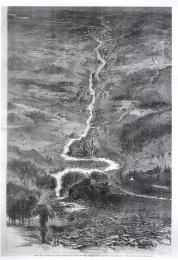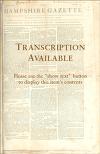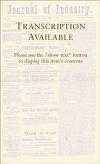|

"Mill River Calamity" from "Harper's Weekly"

Page from Amasa Jones diary regarding Mill River Disaster Flood

Page from Josiah Allen diary regarding Mill River Disaster Flood

"Daily Graphic" newspaper illustration- 'Birdseye View of the Williamsburgh Reservior with the Ruined Dam'

"True Heroes" article from scrapbook kept by Celia M. Kimball

"Harper's Weekly Journal of Civilization" illustrations of Mill River Disaster Flood

"The Mill River Disaster" article from the Journal of Industry newspaper
|
Summary and Objective
Students will understand that the Mill River Disaaster was both preventable and a devastating personal, public and economic loss to this area of the Pioneer Valley. Students will view and read excerpts of newspapers and diaries published in 1874 and use both inference and deductive reasoning techniques to draw conclusions concerning what happened here, who was at fault and lastly how this understanding should motivate them to think that what was learned from this disaster should initiate an activism for them to act responsibly both locally and globally as future citizens.
Teaching Plan
Step 1.
Pre-Activity:Initiate a discussion which incorporates prior knowledge of the role of water in powering the mills of New England villages in the early industrial age. Why was water used? How was water power harnessed? What were the advantages and disadvantages of using water?
Step 2.
In pairs, students will be instructed to examine the etching of the Mill River Area as published in the Harpers Magazine On June 6th, 1874. (*Ideally, viewing this etching on-line utilizing the "Look Closer" feature at the "American Centuries" website is optimal, however if no computer lab is available, hand-held magnifying glasses can be used on "hard copies".) Students will begin at the top of the page noting what they observe and what they conclude concerning the relationship between the surrounding land and water (Mill River) featured in the drawing. They will write this information on chart paper to share and compare with their classmates.
Step 3.
Assemble two pairs into a group of four and give each group a copy of the single page diary enties of both Josiah Allen and Amasa Jones and instruct them to list facts and possible inferences based on those facts as written on May 16 and 17, respectively.(Each group will choose a recorder to write the groups' ideas and observations.)
Step 4.
Bring the class back together as a group and give each individual a copy of "Daily Graphic" newspaper illustration- 'Birdseye View of the Williamsburgh Reservior with the Ruined Dam' and discuss this etching as well as prior materials used in a class to draw conclusions about the possible devastion that occured as a result of this disaster.
Step 5.
Using information found at the MASS Moments website (Dam Breaks Causing Catastrophic Flood) provide the class with background knowledge of who built the dam and why, explain its cost and construction providing a diagram of the engineering plan on an overhead. (* For teachers who would like to investigate this incident further a book entitled In The The Shadow Of The Dam by Elizabeth Sharpe is an excellent reference.)
Step 6.
For homework, instruct the students to read the "True Heroes" article from the scrapbook kept by Alice M. Kimball and view "Harper's Weekly Journal of Civilization" illustrations of Mill River Disaster Flood.
After reading each student should be able to answer this question: Were these men heroes or villains and what evidence do we have to support this position one way or another?
Step 7.
Begin class by reading aloud "The Mill River Disaster" article from the Journal of Industry newspaper. Using the students' responses to the homework and in-class reading,the illustration and guiding question invite them to share through discussion their collective insights as to who were the heroes and villains of this disaster. Create a three columned chart on the board listing in the first column "players", the second column heroes and in the last column villains. A list of all the "players" in this event should include Cheney and Graves, the legislation, proprietors of the reservoir, engineers,contractors, and county commishioners. The representation of their verbal discussion on the chart should provide a visual reference which allows students the opportunity to compare the "evidence" provided by the various players.
Step 8.
Post-Activity: Reassemble the groups of four and direct them to the third Web Site listed entitled "China's Big Dam" and ask each group to ivestigate what has been happening with the dam in China. Have students brainstorm their findings on a chart and then evaluate these ideas of what China's big dam can teach us about land and water considerations today. Is there a potential for disaster? If so, who are the potential heroes and villains? An alternative could be to discuss what could be done to avoid a potential disaster. Display each groups' chart around the classroom and invite on-going research into this topic throughout the remainder of the year.
|




